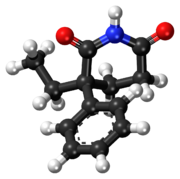
Back قلوتاتیمید AZB Glwtethimid Welsh Glutethimid German Glutetimida Spanish گلوتتیمید Persian Glutetimidi Finnish Glutetimid Croatian Glutetimide Italian Glutetimid Polish Glutetimida Portuguese
 | |
 | |
| Clinical data | |
|---|---|
| Trade names | Doriden, Elrodorm, Noxyron, others |
| Pregnancy category |
|
| Dependence liability | Moderate - high |
| Routes of administration | By mouth |
| ATC code | |
| Legal status | |
| Legal status |
|
| Pharmacokinetic data | |
| Bioavailability | Variable (Tmax = 1–6 hours)[2] |
| Protein binding | ~50% |
| Metabolism | Extensive hepatic |
| Elimination half-life | 8–12 hours |
| Excretion | Renal |
| Identifiers | |
| |
| CAS Number | |
| PubChem CID | |
| IUPHAR/BPS | |
| DrugBank | |
| ChemSpider | |
| UNII | |
| KEGG | |
| ChEMBL | |
| CompTox Dashboard (EPA) | |
| ECHA InfoCard | 100.000.921 |
| Chemical and physical data | |
| Formula | C13H15NO2 |
| Molar mass | 217.268 g·mol−1 |
| 3D model (JSmol) | |
| Melting point | 84 °C (183 °F) |
| Solubility in water | 999 mg/L (30 °C/86 °F) mg/mL (20 °C) |
| |
| |
| (verify) | |
Glutethimide is a hypnotic sedative that was introduced by Ciba[3] in 1954 as a safe alternative to barbiturates to treat insomnia. Before long, however, it had become clear that glutethimide was just as likely to cause addiction and caused similar withdrawal symptoms. Doriden was the brand-name version. Current production levels in the United States (the annual quota for manufacturing imposed by the DEA has been three grams, enough for six Doriden tablets, for a number of years) point to its use only in small-scale research. Manufacturing of the drug was discontinued in the US in 1993 and discontinued in several eastern European countries in 2006.

- ^ Anvisa (2023-03-31). "RDC Nº 784 - Listas de Substâncias Entorpecentes, Psicotrópicas, Precursoras e Outras sob Controle Especial" [Collegiate Board Resolution No. 784 - Lists of Narcotic, Psychotropic, Precursor, and Other Substances under Special Control] (in Brazilian Portuguese). Diário Oficial da União (published 2023-04-04). Archived from the original on 2023-08-03. Retrieved 2023-08-16.
- ^ Barceloux DG (2012). Medical Toxicology of Drug Abuse: Synthesized Chemicals and Psychoactive Plants. Hoboken, N.J.: John Wiley & Sons, Inc. pp. 492–493. ISBN 978-0-471-72760-6. OCLC 814224300.
- ^ US patent 2673205, Hoffmann K, Tagmann E, "3-Disubstituted Dioxopiperidines and the Manufacture thereof", issued 23 March 1954, assigned to CIBA
© MMXXIII Rich X Search. We shall prevail. All rights reserved. Rich X Search